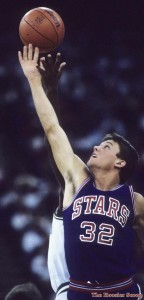Past Imperfect: The Boy From Bedford
Posted by JWeill on February 10th, 2011Past Imperfect is a series focusing on the history of the game. Every Thursday, RTC contributor JL Weill (@AgonicaBoss | Email) highlights some piece of historical arcana that may (or may not) be relevant to today’s college basketball landscape. This week: the boy wonder Damon Bailey.
It doesn’t seem odd to us these days to see kids touched by the grace of the basketball Gods at 14 and 15 years old, kids deemed saviors by followers of the game and coaches, too. Oh, sure, we act aghast that a coach would offer a scholarship to a 14-year-old, then we applaud and massively reward coaches who reel in the top talent, the very kids who have generally been courted since they were in junior high. But years ago, this still seemed something beyond the game. In an era where going pro early meant leaving as a junior, identifying and — more so — publicizing the exploits of a pre-high school-age player came across as crass, perhaps even unethical. My how times change.
Ignoring for the moment a decade in which high school kids were handed the keys to the NBA castle, we have become so inured to the phenomenon of the phenom, so accustomed to the custom of the precocious freshman, we no longer think it all that strange that kids are being identified and categorized and ranked and evaluated at an early age. It seems, well, normal. And why shouldn’t it? Last season, two freshmen were named first-team All-America, and this season many feel another freshman, Jared Sullinger, could be Player of the Year. That’s not a problem. That’s just the way it is.
Two decades ago, freshmen were certainly scrutinized, and plenty saw of minutes. The Fab Five entered college in the fall of 1991 and changed the way freshmen were regarded forever. But even then, in the pre-dawn of the age of the freshman, tapping a kid as a star before he has even settled on a high school seemed somehow too much. And then there was Damon Bailey.
* * *
The story came straight out of the big screen: Once upon a time in Indiana, a blond-haired kid with a square jaw and a jump shot is called one of the best basketball players in America. He outmuscles bigger players and out-quicks smaller ones. He can pass, he can score. He is tough-nosed and plays aggressive face-up defense and knows how to win. In fact, his team is undefeated two years in a row. A legendary college coach comes to watch him work. Of course, the star of this story has never played a minute of high school basketball. This is because he is still in the eighth grade.
The classic basketball film Hoosiers came out in 1986. A year later, Damon Bailey echoed the ethos of that iconic movie when he arrived on the basketball scene with a flourish, thanks to a writer and a Hall of Fame coach. That Bailey had little in particular to do with his fame is a story in and of itself – a script within a script.
This script shows Indiana University head coach Bob Knight – by that time a three time national champion and the physical embodiment of Hoosier basketball – coming to see this 14-year-old kid play, standing at the door with his arms folded as commotion abounds due to his very presence. Afterwards, Knight, in a bit of Knightian hyperbole, states to his coaches that the kid is better than the guards Indiana has at the time. Then the writer reports it, and the legend begins.
In an era before the Internet, before fans could see clips of high school stars — heck, junior high stars – dunking and juking and sweet shooting past and over outclassed opponents, it took a lot to get noticed by the national sports media. Yes, there were Five-Star Camps and recruit ranking services and nationally recognized recruiting analysts. It’s big-time basketball, so of course there was. But it wasn’t quite yet the sport unto itself it is now, and, more importantly, it wasn’t something readily accessible to the general college basketball fan, save possibly a back-page mention in a Street & Smith’s or Blue Ribbon preseason magazine.
But Damon Bailey got noticed. That’s what Bobby Knight coming to your junior high game can do for you. It’s also because Bailey’s presence (and Knight’s) was featured prominently in John Feinstein’s bestselling yearlong excursion into an Indiana Hoosiers season, A Season on the Brink. That’s where the story of Knight’s visit to the tiny gym in Shawswick first came to light.
And it’s also because Bailey was very, very good at basketball. But if the story of Damon Bailey was just making itself known to fans of the college game outside Indiana, the legend of Damon Bailey was already well under way in Hoosier-land.
* * *
Bedford, Indiana, is not a big place. Just 14,000 people or so. It’s the kind of place where being a good basketball player is a big deal. And it’s the kind of place where being a basketball legend is the biggest deal there can be. Damon Bailey was as big a deal as Bedford had ever produced. In November of 1986, no less than Sports Illustrated tabbed Bailey the country’s best ninth-grade hoopster. Add this to the praise afforded him by Coach Knight, and you can imagine that it would be tough for any kid to live up to that kind of hype. And it was, and it is. But that’s what Bailey did, beginning right away as a high school freshman.











































